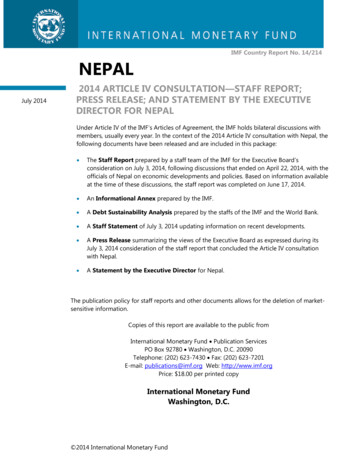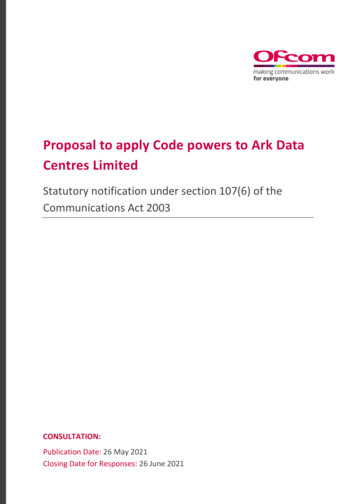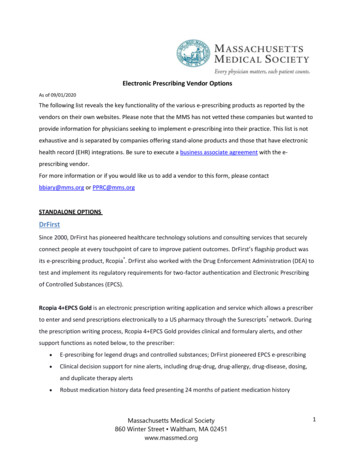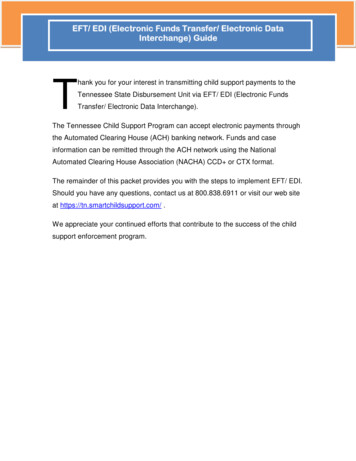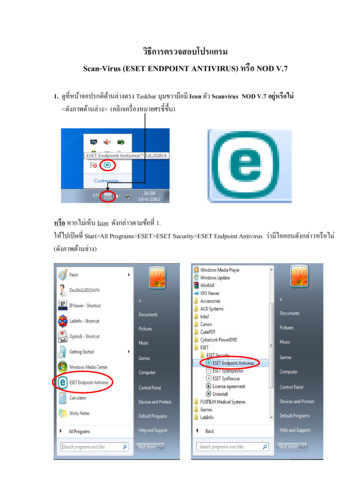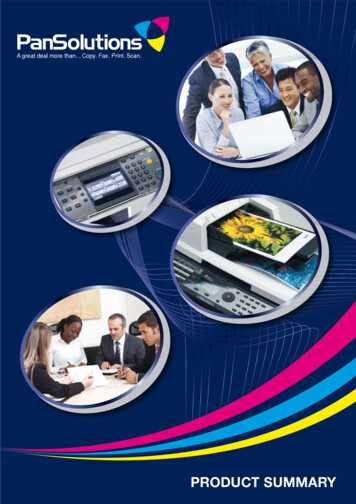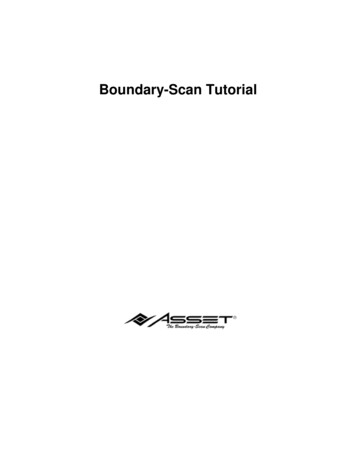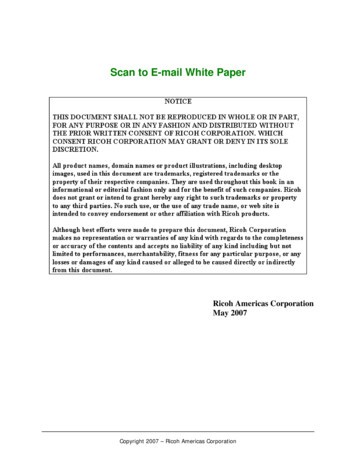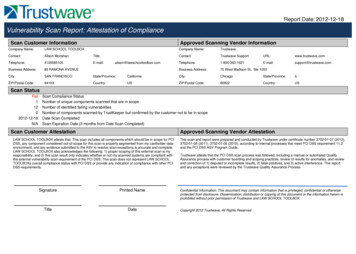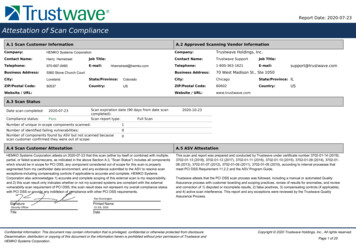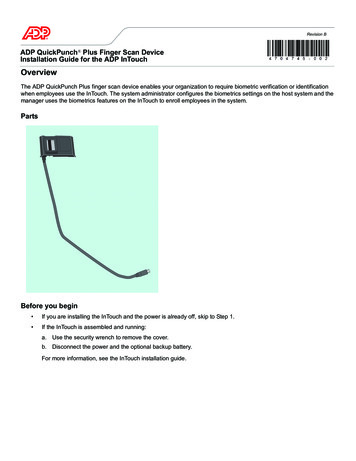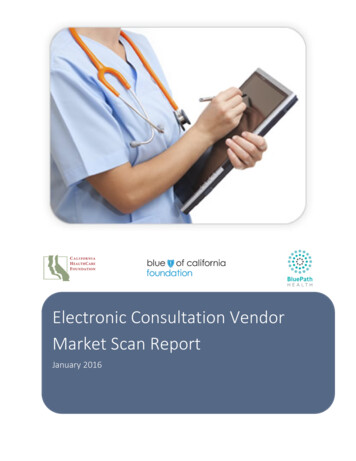
Transcription
Electronic Consultation VendorMarket Scan ReportJanuary 2016
OverviewBlue Shield of California Foundation (BSCF) recognizes the opportunity for safety net organizations toincorporate electronic consult (eConsult) messaging between primary care providers (PCPs) andspecialists to reduce factors such as wait times for specialist consultations, volume of unnecessary faceto-face visits, costs of care, and disconnects in flow of communications between providers. eConsultholds the potential to enhance and improve overall patient experience and care.eConsults demonstrate significant improvements in specialist input and in cost-effective care deliveryfor patients. If a face-to-face visit is deemed necessary following an eConsult, a specialist can convertthe encounter to a referral. In addition, patients always have the option to seek specialist care.PurposeThe objective of this report is to provide information on currently available eConsult technology in orderto inform healthcare organizations such as safety net hospitals and clinics throughout California thatmay be interested in incorporating such software solutions and workflows into their day-to-dayoperations.This report is not an evaluation of vendors and not intended to be a comparative study. Instead, it offersan overview of vendor-provided information to help organizations understand the eConsult landscape,providing common technology requirements and insight into feature availability. This information mayhelp healthcare organizations reduce upfront research when considering eConsult and move morequickly to engaging vendors and determining the best-fit solutions for their businesses.eConsult DefinitionFor the purposes of this document, eConsult is defined as1an asynchronous exchange initiated by thePCP to a specialist, with the specialist responding within a defined period of time in lieu of an in-personvisit.Ideally, these exchanges use structured templates developed and implemented within the electronichealth or medical record (EHR/EMR) to create a seamless, point-of-care set of tools that facilitate higherquality coordination and communication between providers. However, during the market researchprocess, it became evident that eConsult solutions are mostly offered outside the EHR but can integratedata from EHRs as needed.Market Analysis Research MethodsIn order to gain an understanding of common features offered by eConsult technology vendors,BluePath Health requested responses to a requirements survey and a product demonstration from each11 Journal of Telemedicine and Telecare; Article – Electronic consultations (e-consults) to improve access tospecialty care: A systematic review and narrative synthesis. Authors: Varsha G Vimalananda, Gorie Gupte, SiamakM Seraj, Jay Orlander, Dan Berlowitz, B Graeme Fincke and Steven R Simon.1
participating vendor. Requirements survey items were based on a combination of a review of currentindustry offerings and provider organization feedback, making the list of requirements as exhaustive aspossible. Vendor demonstrations were based on a pre-set series of use cases that incorporated multiplelevels of eConsult use, administration and reporting. The process for reviewing eConsult vendorsincluded the following steps.eConsult VendorsInitial research into vendors revealed that eConsult capabilities exist across three segments of thehealthcare IT market. For the purposes of this report we define those segments as follows:1. Stand-alone eConsult Solutions – Vendors that provide specific functionality and in many casesonly eConsult (and/or eReferral) as the core product.2. Electronic Health Records (EHR) – Vendors that provide full EHR functionality within whicheConsult may be a component.3. Enterprise/HIE/Care Management Platforms – Non-EHR vendors that provide a broad healthcaresoftware offering such as HIE, Care Management platform, healthcare customer relationshipmanagement (CRM) or other with eConsult as just one component part of the whole.SURVEYEDStandalone12Enterprise9EHR - 5RESPONSESStandalone5Enterprise5EHR - 0It is important to note that no EHR vendors responded to the survey. While the survey received noresponses from EHR vendors, we are aware that some form of eConsult functionality exists withinvarious EHRs, despite that functionality in many cases not meeting the core functionality requirementsnoted within the survey. For example, use of the Direct messaging protocol often provides the abilityfor clinicians to initiate a consultation using an EHR system. Direct messaging is a way to securely sendhealth information over the Internet. Also known as Direct Exchange, this protocol allows for simple,HIPAA-compliant, encrypted transmission of Protected Health Information to or from any Directaddress. Orders, records, results, and any other documents can be easily and securely transmitted.2
The Direct messaging protocol is inherent within all Meaningful Use Stage 2 certified EHR vendors and insome discussions was noted as an offering to bridge eConsult and EHR vendors. Discussions with alimited number of high visibility EHR vendors revealed that Direct messaging has limitations and may beoffered as a work around solution in the interim period between a vendor offering full eConsultfunctionality or a healthcare organization selecting a tool that offers full eConsult features andfunctions.Market Scan FindingsFor the purposes of the market scan, findings were placed into the following compartments:1.2.3.4.5.6.Vendor ParticipantsSystem InfrastructureCore eConsult FunctionalityIntegration (Product and Data)ReportingServices and SupportEach component offers an understanding of how vendors meet common requirements introduced forthe market scan based on clinician and technology staff feedback within organizations participating in aneConsult grant program.3
Vendor ParticipantsVendors that participated in the market scan process include the following:VendorAmerican WellAristaMDeCeptionistMedUnisonOrion HealthReferral MDRubiconMDSafety e DescriptionFounded in 2007, American Well offers patients and providers access to completetelehealth services including immediate live video visits at any location.Founded in 2014, AristaMD provides eConsult solutions to eliminate unnecessaryspecialty visits and reduce the cost of care, increases quality of care and improveaccess to care.Founded in 2004, eCeptionist enables clients to reduce costs and optimize healthcareservices using tools such as referral management, eConsult and telehealth services.Founded in 2000, MedUnison provides Doc2Doc, helping to solve the challenges ofthe delivery of care facing most organizations today, ensuring collaborativecommunication throughout medical neighborhoods and enhancing access to specialtycare in rural health settings.Founded over 23 years ago, Orion Health is on a mission to revolutionize the wayhealthcare is delivered. We believe that our software solutions, have the ability togive everyone healthier, happier and longer lives.Founded in 2011, ReferralMD’s mission is to standardize referral networkcommunications across the healthcare continuum to reduce costs, improve patientaccess to care, and increase quality for the communities they serve.Founded in 2012, RubiconMD is a population health management solution thatconnects primary care providers to networks of top specialists for quick e-consults,bringing appropriate specialty expertise into the primary care setting. These econsults eliminate avoidable referrals, improve existing referrals and enhance thepatient and physician experience.Since 2007 Safety Net Connect has provided a multitude of successful and nationallyrecognized web based healthcare solutions that serve the underserved and safety netpopulations.Salesforce Health Cloud is setting a new standard for patient management softwarethat goes beyond electronic medical records alone.Founded in 2012, Stella Technology provides products and consulting services thatenable clinicians and patients to ‘exchange, coordinate and collaborate’ Caredinationprovides eConsult functionality with seamless integration into existing technologyecosystems.Product NameAmwellSolution TypeEnterprise – Care ManagementReferral IntelligencePlatformStand-aloneeCeptionist ReferralEnterprise - TelehealthDosSynergyDoc2DocStand-aloneOrion Health iconMDPlatformStand-aloneeConsultStand-aloneHealth CloudEnterprise - CRMCaredinationEnterprise – Care Management4
While pricing information was not sought for the purposes of this scan, vendors were polled for a highlevel understanding of pricing models. All vendors offer a subscription model with potential by a selectfew to have a perpetual license model in the instance a healthcare organization may opt for that model.Specific vendor pricing and model discussions should be performed directly with vendors during anyevaluation process by organizations to understand the best fit from a licensing and budget perspective.Pricing options will vary based on healthcare organization size, integration needs and volume of endusers, along with specific services requested by clients.System InfrastructureThe vendor survey broke infrastructure into 2 segments:1. Architecture/Solution Models2. Privacy and SecurityArchitecture/Solution ModelsAll vendors offer a Software as a Service (SaaS)-based model allowing for lower upfront hardware costsand potential for reduced implementation timeframes based on pre-established cloud-based hosting ofsolutions. Where healthcare organizations may require a locally hosted model, that option is availablewith a subset of vendors.Using the SaaS model, vendors indicated that solutions would work on any current computer with astandard internet connection and browser application. While vendors did not provide specificthresholds associated with minimum requirements for browsers, it is recommended to check withvendors prior to purchase and implementation to ensure organizations are compliant with minimumrequirements.In the case of locally hosted models, minimum hardware and software requirements generally met thefollowing criteria:Application Server CPURAMHDDWIN 2008 or greaterDatabase Server CPURAMHDDWin 2008 or greaterMS SQL R2 STD2 X 2GHz4GB60GB2 x 2GHz4GB100GBPrivacy and SecurityVendors were surveyed for key attributes associated with data and application privacy and security.All vendors reported HIPAA compliance and offer: Data encryption, while data is at rest in the database.5
User authentication, using user name and password security. Single sign on (SSO) is alsoaddressed within the Integration section.Secure transmission of messaging using Secure Socket Layer (SSL) encryption.User audit trails for all access, views and transactions within the solutions.6
Core eConsult FunctionalityVendors met the majority of core functionality requirements provided as part of the survey. Based on clinician and healthcare administratorfeedback, BluePath developed a minimum viable set of requirements. They included:ApplicationRequirementPatient IDMatchingPayer Data TransmissionPatient SearchTemplate Customizationby SpecialtyMessage UrgencyRouting RulesEngine/AutomationProvider Status ChangeClinical GuidelinesPre-AuthorizationRoutingBilling CodingeConsult Reassignment/DeclinePatient CommunicationsDescriptionDoes the solution provide a universal patient identifier consistent withthe EHR system?Does the solution transmit payer data with eConsult messages?Does the product offer a patient search capability?Does the product offer message customization by specialty?Can messages be flagged for urgency of the request by providers?Does the solution offer a rules engine that will automatically send arequest to a specialist based on his/her availability and the patient'scriteria (e.g. insurance and geography)?Does the solution offer specialty provider status changes in order toinform PCPs of specialist availability (e.g. not accepting new patients, onleave, etc.)?Does the solution offer the ability to embed guidelines for use byreferring providers?Does the solution provide the ability to communicate for preauthorization in the event it may be required by a payer?Is there a capability built into the solution that offers coding for billingpurposes?Does the product provide the ability for Specialists to decline and/orredirect requests from PCPs?Does the product provide the ability for the PCP and specialistcommunications to incorporate the patient in the dialogue process?Vendors MeetingRequirement100%Vendors w/Requirementon %90%10%70%30%100%0%30%20%2The inclusion of clinical guidelines involves varying levels of sophistication and customization based on the solution. It is advised to consult directly withvendors of interest as to specific capabilities since features range from in-depth pre-built clinical guideline templates to user build customization availability.7
Based on review of surveys and demonstration observations, the market scan found just two areas inwhich 30% or more of eConsult vendors will require further consideration associated with features andfunctions. They are: Offering billing codes as part of the transaction data transfer process.The majority of health plans do not currently reimburse for eConsults, making this component a“nice to have” for tracking and reporting at present. Where vendors reported that thiscapability does not exist, they did report it as a development roadmap item, meaning thatwithin the next 6 months, vendors will have this capability included within their applications. Offering patient communication as part of the process.This was the most significant gap across the entire scan process, although, it is noted that bymid-2016 50% of vendors will offer features that make this capability possible. Solutionsmeeting this requirement do so by offering the ability for PCPs to approve the inclusion ofpatients in the communications process.Solutions commonly offered the ability to input a clinical question to be viewed and responded to byspecialists. Vendors focus on 2 items: Keeping the consult initiation process simple as a means of limiting the number of additionalworkflow/process steps; andOffering clinical guidelines associated with the consult to ensure appropriateness of the requestand sufficient detail provided to the specialist, in order to reduce the need for follow-upquestions between specialist and PCP.One item of notable interest within the core functionality set includes: Automation of routing varied by vendor. Offerings include routing based on combinations ofPCP feedback from specialists, timeliness of responses and frequency of consults, amongst othercharacteristics that provided the ability to route consults to specialists. .Integration (Product and Data)Integration was split into two areas for the purposes of the survey:1. Systems integration2. Data integration including scheduling integration and inclusion of specialist networksSystems Integration LandscapeVendors provide the ability to integrate with EHRs and other systems within healthcare organizations.While the scan process could not determine how deeply embedded the eConsult solutions may beintegrated within EHRs since EHR systems would be required in the demonstration process, at least onevendor offered a short video illustrating integration within a mainstream certified EHR system.8
Requirements associated with systems integration included:ApplicationRequirementEHR / HIE IntegrationSingle Sign OnDescriptionDoes the eConsult solution provideintegration with external systems such asEHR and HIE?Does the solution offer single sign oncapability from within EHR or othersolutions (including context sensitivity)?VendorsMeetingRequirement100%Vendors w /Requirementon Roadmap0%100%0%Of note is the ability for vendors to provide single sign on3 (SSO). This is an advancement with manyvendors during the last 12 months. SSO was reported in all cases to include context sensitivityassociated with patient information, easing the burden associated with clinician workflow when movingbetween systems. Vendors reported the ability to have links available within EHR products as a meansof keeping focus and workflow within one application environment while offering the use of theeConsult tool as a ‘pop-up’ screen as needed.Data IntegrationVendors were surveyed to gain an understanding of data integration capabilities and what formats aresupported in the transport of data between systems. Common formats included: CCDA for clinical documentation of continuity of careHL7 2.X, XML and API connectors for the transport of demographics and clinical dataThe survey focused on demographic and treatment history data integration primarily since these datadrive the ability for the specialist to have a clear picture of the patient and care need. All vendorsreported the ability to integrate demographic and clinical data within their solutions.While appointment linkage is not a critical component within the workflow for eConsult, the surveysought an understanding of the potential for escalation of the consult to a referral appointmentbetween a patient and specialist. Several products stated that appointment linkage is available.3Single Sign On controls access to multiple related, but independent, software systems. With SSO, a user logs inwith a single ID and password to gain access to a connected system or systems without using different usernamesor passwords, or, in some configurations, seamlessly signs on at each system.9
Data s/Results DataClinical ImagesClinicalDocumentationAppointment LinkageSpecialist NetworkinclusionDescriptionAre patient demographics imported intothe solution? Provides ongoing linkagebetween solution and EHR?Can treatment history data containmedication data?Can orders and results data from the EHRbe attached to eConsult requests?Does the solution offer the ability toattach images?Does the solution offer the ability to storeand forward clinical documentationintegrated via an EHR or other system?Does appointment linkage with thespecialist exist in order for the PCP officeto identify and confirm an appointmentdate for a face-to-face with thespecialist?Do systems offer supplemental access tospecialist networks in addition to localfacility specialists?VendorsMeetingRequirement100%Vendors w /Requirementon s commonly indicated that data integration occurs on a project-by-project basis, with specificdata elements requiring analysis based on the EHR or other data system with which the eConsult systemwill integrate.ReportingThe majority of systems offer the ability to produce reports associated with productivity and complianceand offer dashboards for the purposes of management reporting and gap analysis. Many tools offerfeatures that include graphical views into data reports while some systems rely on data exportfunctionality to business intelligence and reporting tools that may exist outside of the immediateeConsult offering for the purposes of graphical reporting. Requirements sought for reporting included:10
ApplicationRequirementActivity ReportsProcess MeasureReportseConsult BacklogReportsFinancial/Billing CodeReportingAd Hoc Reporting forEnd UsersData Exports for 3rdParty UseDescriptionDoes the solution provide activityreporting by specialty (e.g. volume ofconsults, conversion to in-person visits)?Does the solution offer the ability toreport on turnaround time and otherprocess measures?Does the product offer backlog / queuereporting?Does the product provide reportingassociated with codes for billingpurposes?Does the product provide ad hocreporting capabilities using selectionitems within the app?Does any data export capability exist, forexample, for use with data
The Direct messaging protocol is inherent within all Meaningful Use Stage 2 certified EHR vendors and in some discussions was noted as an offering to bridge eConsult and EHR vendors. Discussions with a limited number of high visibility EHR vendors
